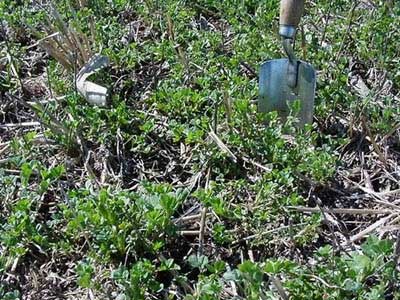|
April 9, 2004
by
Dean Malvick
The
Bulletin
Univeristy of Illinois at
Urbana-Champaign
Alfalfa in Illinois in April can be looked at in
at least two ways. One is the established alfalfa fields, which
are growing vigorously in most areas of Illinois and are well on
the way to producing the first crop for 2004. Another is the
fields planted this spring. Both are susceptible to multiple
diseases. With the value of alfalfa and the costs for reseeding
in mind, it can pay to closely monitor and scout fields to
determine whether and which diseases are causing problems so
that management plans for specific diseases can be planned to
maximize yield, quality, and profit for the alfalfa crop.
Information and photographs for the most important alfalfa
diseases in Illinois can be found at the University of Illinois
Field Crop Diseases Web site (www.cropdisease.cropsci.uiuc.
edu).
Early-season growth of alfalfa in a
1-year old field in north-central
Illinois.
(Photo by J. Morrison).
Early-Season Diseases in Established Stands
Several diseases can cause significant damage to
alfalfa stands early in the season. Some of these are the same
ones that cause later problems, including bacterial and Fusarium
wilts, Verticillium wilt, anthracnose, crown rot, and
Phytophthora rot. These diseases, with the exception of crown
rot, can generally be managed with good alfalfa varieties that
have high levels of disease resistance. Two other diseases can
be of particular concern at this time of the year: spring black
stem and Sclerotina crown and stem rot.
Spring black stem and leaf spot (caused by the
fungus Phoma medicaginis) is a common disease in the cool
times of the year that can reduce yield and forage quality. Dark
brown to black spots develop on the leaves, which can expand and
cause yellowing. Leaf drop may result, especially in the lower
canopy of dense stands, which often stays moist. Dark lesions
may develop on stems and and kill them. This disease is favored
by wet and cool conditions and can develop quickly when
conditions are favorable. The alfalfa crop should be harvested
as soon as possible if this disease becomes severe in order to
minimize losses of yield and quality. High levels of resistance
to spring black stem are not available in alfalfa cultivars.
However, good new varieties adapted to your area may suffer less
damage from this disease than older varieties. Losses from
foliar diseases can generally be minimized with good management
practices and fertilization, especially using potassium.
Another disease that can cause considerable
damage to young alfalfa stands, especially stands in the
southern half of Illinois that were seeded last fall, is
Sclerotinia crown and stem rot. At this time of the year, damage
from this disease may be seen as dead patches of plants or
plants with wilting or dying stems. On closer inspection,
infected plants often are soft and rotting, covered in part with
white fungal growth, and they contain small (1/8 inch to 1/4
inch), rounded black fungal structures. These plants typically
have infected internal crown tissue that is brown to yellow in
color. Sclerotinia crown and stem rot of alfalfa in Illinois is
thought to be caused primarily by the soilborne fungus
Sclerotinia trifoliorum, which is a different species than
what causes white mold of soybean. This disease is managed by
planting in spring, rotating away from alfalfa and clover, and
using the most resistant cultivars available.

Diseases in newly planted fields
Soilborne diseases that cause pre- and
postemergence damping-off of alfalfa seedlings can be a major
concern for successful stand establishment. Three diseases of
particular concern are Pythium rot and damping-off, Phytophthora
rot and damping-off, and Aphanomyces root rot. All of these
diseases are favored by wet soil conditions. Pythium and
Phytophthora often kill seedlings rapidly, before plants
become severely discolored, whereas Aphanomyces tends to
kill plants more slowly, while causing stunting and
yellow-purple discoloration of cotyledons and leaves. Each of
these diseases can be managed to some degree by avoiding wet
fields. Treatment of alfalfa seed with the fungicides metalaxyl
(Allegiance) or mefenoxam (Apron XL) provides effective
protection for seed and seedlings against Pythium and
Phytopthora. Aphanomyces cannot be managed with
fungicides. Cultivars are not available that are resistant to
Pythium. Many alfalfa cultivars have excellent resistance to
Phytopthora and race 1 of Aphanomyces.
Aphanomyces root rot, caused by Aphanomyces
euteiches, may be of particular concern, because we have
found this pathogen to be very widespread in Illinois alfalfa
fields. This disease is typically most damaging to seedlings and
can dramatically thin stands and reduce vigor and yield of
infected plants. Races 1 and 2 of Aphanomyces euteiches
are very common in Illinois alfalfa fields. Resistant alfalfa
varieties should be used to manage Aphanomyces root rot,
especially where fields are prone to slow drainage and where
seedling establishment problems have been noted in the past.
Most certified varieties are resistant (R) or highly resistant
(HR) to Aphanomyces root rot race 1. Resistance to race 1 does
not protect against race 2. Thus, based on our new knowledge of
race 2 in Illinois fields, resistance to races 1 and 2 is
needed in many fields to protect plants against Aphanomyces root
rot. Several alfalfa varieties are available that are resistant
to both races of Aphanomyces.

Field of alfalfa seedlings severely
thinned by soilborne diseases, primarily Aphanomyces root rot.
For diagnosis of these and other crop disease
problems, send samples to the University of Illinois Plant
Clinic in Urbana (217-333-0519;
www.cropsci.uiuc.edu/research/clinic/clinic.html).--Dean
Malvick |